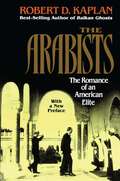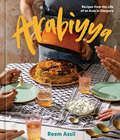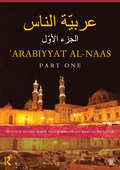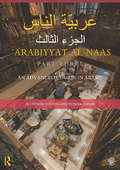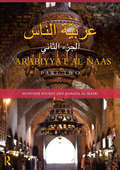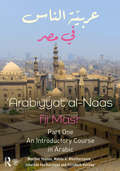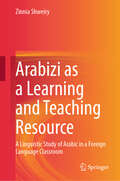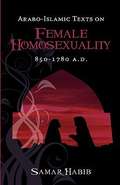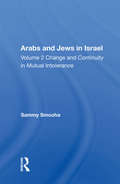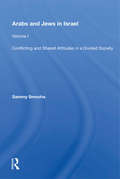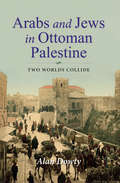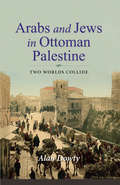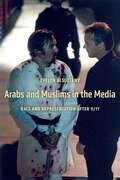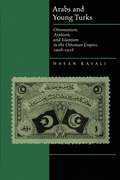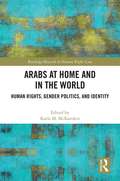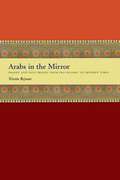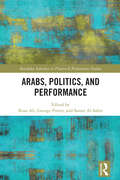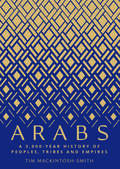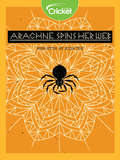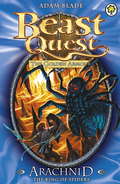- Table View
- List View
Arabidopsis Protocols (Methods in Molecular Biology #82)
by Julio Salinas José M. Martínez-ZapaterInternationally recognized experts offer a comprehensive collection of significant new methods for gene mapping, cloning, and reverse genetics, as well as updated standard protocols for work with Arabidopsis genetics and molecular biology. These time-tested methods range from techniques for the successful growing of Arabidopsis to strategies for gene cloning. The sections on genetics, transformation, and gene expression analysis will be especially helpful to scientists involved in mutant analysis or in producing and analyzing transgenic plants. In many cases, the protocols can also be applied to other plant species, with minor adjustments. Serving both experienced researchers and beginners in the field, Arabidopsis Protocols will immediately become the standard reference for laboratories working with Arabidopsis, the plant of choice to approach many fundamental questions in plant biology.
Arabidopsis Protocols, 2nd Edition (Methods in Molecular Biology #323)
by Julio Salinas Jose J. Sanchez-SerranoThis collection of readily reproducible Arabidopsis protocols has been updated to reflect recent advances in plant biology, the completion of the Arabidopsis genome sequence, which is essential for studying plant function, and the development of whole systems approaches that allow global analysis of gene expression and protein and metabolite dynamics. The authors have included nearly all techniques developed in Arabidopsis, others recently adapted from the traditional work in crop species, and the most recent ones using Arabidopsis as a model system. Highlights include the most recent methods-transcriptomics, proteomics, and metabolomics - and their novel applications (phosphoproteomics, DNA microarray-based genotyping, high throughput metabolite profiling, and single-cell RNA).
Arabists: The Romance of an American Elite
by Robert D. KaplanA tight-knit group closely linked by intermarriage as well as class and old school ties, the “Arabists” were men and women who spent much of their lives living and working in the Arab world as diplomats, military attaches, intelligence agents, scholar-adventurers, and teachers. As such, the Arabists exerted considerable influence both as career diplomats and as bureaucrats within the State Department from the early nineteenth century to the present. But over time, as this work shows, the group increasingly lost touch with a rapidly changing American society, growing both more insular and headstrong and showing a marked tendency to assert the Arab point of view. Drawing on interviews, memoirs, and other official and private sources, Kaplan reconstructs the 100-year history of the Arabist elite, demonstrating their profound influence on American attitudes toward the Middle East, and tracing their decline as an influx of ethnic and regional specialists has transformed the State Department and challenged the power of the old elite.
Arabiyya: Recipes from the Life of an Arab in Diaspora [A Cookbook]
by Reem AssilA collection of 100+ bright, bold recipes influenced by the vibrant flavors and convivial culture of the Arab world, filled with moving personal essays on food, family, and identity and mixed with a pinch of California cool, from chef and activist Reem Assil &“This is what a cookbook should be: passion, politics, and personality are woven through the fabulous recipes.&”—Ruth Reichl, author of Save Me the PlumsONE OF FOOD52&’S MOST ANTICIPATED COOKBOOKS OF 2022Arabiyya celebrates the alluring aromas and flavors of Arab food and the welcoming spirit with which they are shared. Written from her point of view as an Arab in diaspora, Reem takes readers on a journey through her Palestinian and Syrian roots, showing how her heritage has inspired her recipes for flatbreads, dips, snacks, platters to share, and more. With a section specializing in breads of the Arab bakery, plus recipes for favorites such as Salatet Fattoush, Falafel Mahshi, Mujaddarra, and Hummus Bil Awarma, Arabiyya showcases the origins and evolution of Arab cuisine and opens up a whole new world of flavor. Alongside the tempting recipes, Reem shares stories of the power of Arab communities to turn hardship into brilliant, nourishing meals and any occasion into a celebratory feast. Reem then translates this spirit into her own work in California, creating restaurants that define hospitality at all levels. Yes, there are tender lamb dishes, piles of fresh breads, and perfectly cooked rice, but there is also food for thought about what it takes to create a more equitable society, where workers and people often at the margins are brought to the center. Reem's glorious dishes draw in readers and customers, but it is her infectious warmth that keeps them at the table. With gorgeous photography, original artwork, and transporting writing, Reem helps readers better understand the Arab diaspora and its global influence on food and culture. She then invites everyone to sit at a table where all are welcome.
Arabiyyat al-Naas (Part One): An Introductory Course in Arabic
by Maha Saliba Foster Makda Weatherspoon Munther Younes‘Arabiyyat al-Naas (Part One) offers a groundbreaking introduction to Arabic as it is written and spoken by native speakers. It combines a progressive and rigorous grounding in Modern Standard Arabic (MSA) – the form employed for reading, writing and formal speaking – with an innovative integration of the spoken Levantine variety used in everyday situations in Syria, Lebanon, Jordan and Palestine. Introducing the two simultaneously ‘Arabiyyat al Naas (Part One) uses each in its proper context: Levantine for conversations and MSA for reading and writing activities. In this way, the course efficiently prepares students for the practical realities of learning and "living" Arabic today. Features include: 21 theme-based units covering all the core topics expected in a first-year Arabic course, such as countries, clothes, colors, family and professions a broad range of stimulating activities and exercises fostering active engagement with the course and the development of comprehension and communication skills comprehensively covers the 5 Cs: communication, culture, connections, comparisons and communities a free DVD filmed on location in Jordan, presenting over 40 videos and incorporating a wide variety of entertaining and realistic scenarios a free companion website (www.routledge.com/cw/younes) offering a wealth of additional instructor and student resources, including a teacher’s guide, an introduction to the letters and sounds of Arabic (with audiovisual aid and writing demonstrations), audio recordings of songs and listening passages, video clips, sample tests, an answer key and language games clear explanations of grammatical structures and concepts as they occur in the reading and listening materials to encourage progressive learning and active interaction with the text a user-friendly and vibrant full colour text design, richly illustrated throughout with over 200 illustrations and photographs songs with simple lyrics tied to the themes of the course to help advance vocabulary acquisition and understanding of basic grammatical structures. Written by a dynamic author team and tested over a number of years at Cornell University, ‘Arabiyyat al-Naas (Part One) will be an essential resource for students beginning to learn Arabic. While primarily designed for classroom use, the accessibility of the course and website also renders it highly suitable for independent study. This volume is the first in an exciting three-part series of Arabic textbooks which together provide a complete three-year undergraduate language program.
Arabiyyat al-Naas (Part Three): An Advanced Course in Arabic
by Munther Younes Yomna Chami‘Arabiyyat al-Naas (Part Three): An Advanced Course in Arabic builds further on the groundbreaking approach used in Part One and Part Two of the series. It integrates Modern Standard Arabic (MSA) and spoken Levantine in a way specially tailored to the needs of advanced students. Levantine Arabic strongly features in spoken discussions of MSA materials, reflecting authentic practice by native speakers. However, the overall ratio of MSA – the form employed for reading, writing and formal speaking in the Arab world – to Levantine has been increased, supporting students’ mounting need for MSA as they progress further in their education. This textbook is designed to take learners from the Advanced Low to the Advanced High level according to the ACTFL criteria, and from level B2 to C1 on the CEFR proficiency scales. Features include: 18 theme-based units covering topics such as Arab minorities; education; religion; love and marriage; the Arab woman; economics; politics; military matters; and the environment thorough coverage of listening, speaking, reading, and writing skills with clear grammar explanations and lessons structured to provide opportunities for further practice humorous, realistic dialogues reflecting educated speech among Arabs, to build up strong and practical communication skills attention to issues highly relevant to modern Arab society, encouraging active engagement with the course and further exploration of the themes a rich variety of reading passages from contemporary sources such as Al Jazeera as well as excerpts from the classic works One Thousand and One Nights and Kalila wa Dimna an extensive range of stimulating exercises and activities, including crossword puzzles, root-and-pattern identification exercises, passage completions, and free compositions free companion website (www.routledge.com/cw/younes) with the audio tracks, and texts of the listening passages and answer key. Developed by a dynamic author team and tested over a number of years at Cornell University, ‘Arabiyyat al-Naas (Part Three) is an essential resource for advanced-level students of Arabic. While primarily designed for classroom use, the accessibility of the course also renders it highly suitable for independent study. This volume is the final installment of a pioneering three-part series of Arabic textbooks which together provide a complete three-year undergraduate language program. Munther Younes and Yomna H. Chami both teach Arabic at Cornell University, USA.
Arabiyyat al-Naas (Part Two): An Intermediate Course in Arabic
by Munther Younes Hanada Al-MasriArabiyyat al Naas (Part Two): An Intermediate Course in Arabic offers a vibrant course in Arabic as it is written and spoken today by educated native speakers. Not only does it continue the innovative integration of Modern Standard Arabic (MSA) and Levantine Arabic used in Part One of the series, but it does so in a way that supports and develops students’ increased mastery of the language. Combining a greater focus on cultural topics with an increased coverage of MSA, Part Two introduces more sophisticated communication, giving students a deeper awareness of the cultural base of the Arabic language. Features include: Twenty-one theme-based units covering a wide range of relevant and engaging topics, including education and learning, jobs and professions, the Arab woman, religion, money and the economy, politics and government and the environment Thorough coverage of listening, speaking, writing and reading skills in every unit, with lessons structured to provide students with variety, stimulation and further opportunities for practice Humorous, realistic dialogues reflecting everyday educated speech among Arabs to build up strong and practical communication skills A rich variety of reading passages, including poems, short stories, newspaper articles, descriptions of Arab cities and biographies of famous figures, designed to improve comprehension and analytical skills and to deepen students’ knowledge of Arab history, culture, language, and literature An extensive range of appealing exercises and activities, including crossword puzzles, root-and-pattern identification exercises, passage completions, guided and free compositions, and songs Free accompanying CD that includes audio recordings of the listening materials in the 21 units and a number of songs tied to their themes Free companion website (www.routledge.com/cw/younes) featuring the texts of the listening passages, the audio recordings available on the CD , a track list of all the audio materials, the answer keys to the crossword puzzles, sample tests and language games. Developed by an experienced and dynamic author team and tested over a number of years at Cornell University, Arabiyyat al Naas (Part Two) will be an essential resource for intermediate-level students of Arabic. While primarily designed for classroom use, the accessibility of the course also renders it highly suitable for independent study. This volume is the second in a pioneering three-part series of Arabic textbooks which together provide a complete three-year undergraduate language program.
Arabiyyat al-Naas fii MaSr (Part One): An Introductory Course in Arabic
by Makda Weatherspoon Munther Younes Jonathan Featherstone Elizabeth Huntley‘Arabiyyat al-Naas fii MaSr (Part One) offers a ground-breaking introduction to Arabic as it is written and spoken by native speakers. It combines a progressive and rigorous grounding in Modern Standard Arabic (MSA), the register employed for reading, writing and formal speaking, with an innovative integration of the dominant Egyptian variety. Introducing the two simultaneously and seamlessly building on their shared features, ‘Arabiyyat al-Naas fii MaSr (Part One) uses each in its proper context: Egyptian dialect for conversations and MSA for reading and writing activities. In this way, the course efficiently prepares students for the practical realities of learning and living Arabic today. Features include: Expanded grammar explanations and activation drills, including discussions about colloquial and formal similarities and differences A series of authentic video-clips recorded in Egypt to help learners revise the vocabulary and structures then learn unit by unit Extensive classroom activities and homework exercises that provide constant review to reinforce learning Arabic-English and English-Arabic glossaries, reference charts, and a grammar index Songs with simple lyrics tied to the themes of the course to help advance vocabulary acquisition and understanding of basic grammatical structures A companion website (www.routledge.com/cw/weatherspoon) that features fully integrated interactive, self-correcting exercises, audio and video materials, and additional online course management and grading options for teachers A user-friendly and vibrant text design with full colour, richly illustrated throughout with over two hundred illustrations and photos A teachers manual with an Arabic introduction for the teacher, which lays out the structure of the student course book, its methodology and directions and suggestions for its use. Written by experienced teachers of Arabic and experts in Arabic teaching pedagogy, ‘Arabiyyat al-Naas fii MaSr (Part One) is an essential resource for students beginning to learn Arabic.
Arabizi as a Learning and Teaching Resource: A Linguistic Study of Arabic in a Foreign Language Classroom
by Zinnia ShweiryThis book is the first of its genre to explore the use of Arabizi, the Romanized script of the Arabic language that is used online or in chat apps, in the Arabic as a Foreign Language (AFL) classroom. It fills a noticeable, and glaring, gap in teaching a non-Romanized language through Romanized representation by observing and studying Arabizi as a resource that is yet to be acknowledged. As such, the author aptly, and concurrently, addresses concerns and problems that arise in AFL learning. An essential resource for studies in language acquisition, the author carves a new niche in the study of phonology, and phonetics, particularly so in L1 and L2 studies, with succinct and up-to-date examples. Relevant to applied linguistics and language educators in Arabic, it also draws comparisons between Chinese and Arabic alphabets in analyzing L1 and L2 purposes, making it a unique linguistic comparative contribution to the study of languages in classroom settings.
Arabo-Islamic Texts On Female Homosexuality, 850 - 1780 A D
by Samar HabibIncreasingly in mainstream discourse and rhetoric, there only seems to be one very serious and conservative face to Islam, Muslim communities, and their governments. Mainstream modern Islamic hermeneutics condemn homosexual orientations, sometimes with punishments as severe as death. Nevertheless, there were also instances in Muslim history, culture, and society where religiosity was playful not punitive, where the sexual body was inscribed with markers of pleasure not those of perdition. <p><p> Exploring instances within the Arabian Islamic Empire that negate impressions about Muslim cultures as eternally monolithic, conservative, and orthodox, we can come to a better and more nuanced understanding of the complexities of former and contemporary Muslim civilizations. The question of gay and lesbian human rights in the Muslim world is a topical and pressing one, and the need now for alternative ways of approaching Islam in the modern world is more important than ever. The answers to today's modern crisis in human rights for LGBTIQ people lies in looking at the past and highlighting elements that can assist in the creation of a more equitable future. <p> This publication discovers and brings to the English reader an array of surviving texts penned by Muslim scholars discussing female same‐sex desire. From the tolerant days of the Abbasid caliphate to the celebratory text of Yusuf Tifashi in the thirteenth century and onwards toward growing strictures and greater intolerance, Arabo-Islamic Texts reveals a dynamic and lively discourse on sexuality in the Arabo-Islamic empire. The English translation of a lecture delivered in Arabic in Haifa by Samar Habib is also included in this book.
Arabs And Jews In Israel/two Volume Set: Volume 1, Conflicting And Shared Attitudes In A Divided Society
by Sammy SmoohaIn this treatment of the problem of Arab-Jewish coexistence in Israel, which furnishes data on the news of Israel's divided population, Dr. Smooha challenges the gloomy perspective that impediments to peaceful relations between Israel's Jewish majority and Arab minority will inevitably lead to ever more violent confrontation. He asserts instead tha
Arabs And Jews In Israel: Volume 1, Conflicting And Shared Attitudes In A Divided Society
by Sammy SmoohaOn December 9, 1987, the Palestinians on the West Bank and Gaza Strip launched the most serious challenge in this century to non-Arab rule in the area West of the Jordan river. A genuine grassroots movement against protracted occupation and for self-determination, the Intifadeh has already inflicted many losses and scored many gains. By the first anniversary of the uprising, the toll for the revolting Palestinians was at least 280 dead, 4,000 wounded, 5,500 detainees, and some deportations and house demolitions. The substantial suffering and privations also entailed numerous beatings, curfews, arrests, searches, cuts in basic services, closings of schools, and losses of income. The Israelis have had 10 killed, 1,150 wounded, a minimum of a 1.5% drop in the Gross National Product, the stress of a people's,army fighting civilians of an occupied nation, increased international isolation and censure, and the straining of relations with the Diaspora.
Arabs and Iranians in the Islamic Conquest Narrative: Memory and Identity Construction in Islamic Historiography, 750–1050 (Culture and Civilization in the Middle East)
by Scott SavranArabs and Iranians in the Islamic Conquest Narrative analyzes how early Muslim historians merged the pre-Islamic histories of the Arab and Iranian peoples into a didactic narrative culminating with the Arab conquest of Iran. This book provides an in-depth examination of Islamic historical accounts of the encounters between representatives of these two peoples that took place in the centuries prior to the coming of Islam. By doing this, it uncovers anachronistic projections of dynamic identity and political discourses within the contemporaneous Islamic world. It shows how the formulaic placement of such embellishment within the context of the narrative served to justify the Arabs’ rise to power, whilst also explaining the fall of the Iranian Sasanian empire. The objective of this book is not simply to mine Islamic historical chronicles for the factual data they contain about the pre-Islamic period, but rather to understand how the authors of these works thought about this era. By investigating the intersection between early Islamic memory, identity construction, and power discourses, this book will benefit researchers and students of Islamic history and literature and Middle Eastern Studies.
Arabs and Jews in Ottoman Palestine: Two Worlds Collide (Perspectives On Israel Studies)
by Alan DowtyThe historian and expert on Israeli-Palestinian relations offers &“a well-written, well-balanced&” account of cultural conflicts in the region before WWI (Anita Shapira, author of Israel: A History).When did the Arab-Israeli conflict begin? Some discussions focus on the 1967 war, some go back to the creation of the state of Israel in 1948, and others look to the beginning of the British Mandate in 1922. Alan Dowty, however, traces the earliest roots of the conflict to the Ottoman Empire in the 19th century, arguing that this historical approach highlights constant clashes between religious and ethnic groups in Palestine. Dowty demonstrates that, during the 19th century, there was an overwhelming hostility to European foreigners, and that Arab residents viewed new Jewish settlers as European. He also shows that Jewish settlers had tremendous incentive to minimize all obstacles to settlement, including the inconvenient hostility of the existing population. Dowty's thorough research reveals how events that occurred over 125 years ago shaped the implacable conflict that dominates the Middle East today.
Arabs and Jews in Ottoman Palestine: Two Worlds Collide (Perspectives on Israel Studies)
by Alan DowtyWhen did the Arab-Israeli conflict begin? Some discussions focus on the 1967 war, some go back to the creation of the state of Israel in 1948, and others look to the beginning of the British Mandate in 1929. Alan Dowty, however, traces the earliest roots of the conflict to the Ottoman Empire in the 19th century, arguing that this historical approach highlights constant clashes between religious and ethnic groups in Palestine. He demonstrates that existing Arab residents viewed new Jewish settlers as European and shares evidence of overwhelming hostility to foreigners from European lands. He shows that Jewish settlers had tremendous incentive to minimize all obstacles to settlement, including the inconvenient hostility of the existing population. Dowty's thorough research reveals how events that occurred over 125 years ago shaped the implacable conflict that dominates the Middle East today.
Arabs and Muslims in the Media: Race and Representation after 9/11 (Critical Cultural Communication)
by Evelyn AlsultanyAfter 9/11, there was an increase in both the incidence of hate crimes and government policies that targeted Arabs and Muslims and the proliferation of sympathetic portrayals of Arabs and Muslims in the U.S. media. Arabs and Muslims in the Media examines this paradox and investigates the increase of sympathetic images of “the enemy” during the War on Terror.Evelyn Alsultany explains that a new standard in racial and cultural representations emerged out of the multicultural movement of the 1990s that involves balancing a negative representation with a positive one, what she refers to as “simplified complex representations.” This has meant that if the storyline of a TV drama or film represents an Arab or Muslim as a terrorist, then the storyline also includes a “positive” representation of an Arab, Muslim, Arab American, or Muslim American to offset the potential stereotype. Analyzing how TV dramas such as The Practice, 24, Law and Order, NYPD Blue, and Sleeper Cell, news-reporting, and non-profit advertising have represented Arabs, Muslims, Arab Americans, and Muslim Americans during the War on Terror, this book demonstrates how more diverse representations do not in themselves solve the problem of racial stereotyping and how even seemingly positive images can produce meanings that can justify exclusion and inequality.
Arabs and Young Turks: Ottomanism, Arabism, and Islamism in the Ottoman Empire, 1908-1918
by Hasan KayaliArabs and Young Turks provides a detailed study of Arab politics in the late Ottoman Empire as viewed from the imperial capital in Istanbul. In an analytical narrative of the Young Turk period (1908-1918) historian Hasan Kayali discusses Arab concerns on the one hand and the policies of the Ottoman government toward the Arabs on the other. Kayali's novel use of documents from the Ottoman archives, as well as Arabic sources and Western and Central European documents, enables him to reassess conventional wisdom on this complex subject and to present an original appraisal of proto-nationalist ideologies as the longest-living Middle Eastern dynasty headed for collapse. He demonstrates the persistence and resilience of the supranational ideology of Islamism which overshadowed Arab and Turkish ethnic nationalism in this crucial transition period. Kayali's study reaches back to the nineteenth century and highlights both continuity and change in Arab-Turkish relations from the reign of Abdulhamid II to the constitutional period ushered in by the revolution of 1908.Arabs and Young Turks is essential for an understanding of contemporary issues such as Islamist politics and the continuing crises of nationalism in the Middle East.
Arabs at Home and in the World: Human Rights, Gender Politics, and Identity (Routledge Research in Human Rights Law)
by Karla M. McKandersThis volume brings together an interdisciplinary group of scholars from the United States, the Middle East, and North Africa, to discuss and critically analyze the intersection of gender and human rights laws as applied to individuals of Arab descent. It seeks to raise consciousness at the intersection of gender, identity, and human rights as it relates to Arabs at home and throughout the diaspora. The context of revolution and the destabilizing impact of armed conflicts in the region are used to critique and examine the utility of human rights law to address contemporary human rights issues through extralegal strategies. To this end, the volume seeks to inform, educate, persuade, and facilitate newer or less-heard perspectives related to gender and masculinities theories. It provides readers with new ways of understanding gender and human rights and proposes forward-looking solutions to implementing human rights norms. The goal of this book is to use the context of Arabs at home and throughout the diaspora to critique and examine the utility of human rights norms and laws to diminish human suffering with the goal of transforming the structural, social, and cultural conditions that impede access to human rights. This book will be of interest to a diverse audience of scholars, students, public policy researchers, lawyers and the educated public interested in the fields of human rights law, international studies, gender politics, migration and diaspora, and Middle East and North African politics.
Arabs in the Mirror
by Nissim RejwanWhat is an Arab? Though many in the West would answer that question with simplistic stereotypes, the reality is far more complex and interesting. Arabs themselves have been debating Arab identity since pre-Islamic times, coming to a variety of conclusions about the nature and extent of their "Arabness. " Likewise, Westerners and others have attempted to analyze Arab identity, reaching mostly negative conclusions about Arab culture and capacity for self-government. To bring new perspectives to the question of Arab identity, Iraqi-born scholar Nissim Rejwan has assembled this fascinating collection of writings by Arab and Western intellectuals, who try to define what it means to be Arab. He begins with pre-Islamic times and continues to the last decades of the twentieth century, quoting thinkers ranging from Ibn Khaldun to modern writers such as al-Ansari, Haykal, Ahmad Amin, al-'Azm, and Said. Through their works, Rejwan shows how Arabs have grappled with such significant issues as the influence of Islam, the rise of nationalism, the quest for democracy, women's status, the younger generation, Egypt's place in the Arab world, Israel's role in Middle Eastern conflict, and the West's "cultural invasion. " By letting Arabs speak for themselves, Arabs in the Mirror refutes a prominent Western stereotype--that Arabs are incapable of self-reflection or self-government. On the contrary, it reveals a rich tradition of self-criticism and self-knowledge in the Arab world.
Arabs, Politics, and Performance (ISSN)
by Samer Al-Saber Roaa Ali George PotterThis book is a ground-breaking collection on contemporary Arab theatre.Through three sections discussing occupation and resistance, diaspora, migration, and refugees, and nationalism and belonging, this study provides nuanced responses to the contested points of intersection between Arab culture and the West, as well as many of the major concerns within contemporary Arab theatre. The collection draws together scholars from the Middle East, North Africa, Europe, and the United States who write about Arab theatre and the representation of Arabs on European and American stages. It introduces concerns in contemporary Arab theatre, the regions in which Arab theatre is performed, and the issues with representations of Arabs onstage.This volume will be of great significance for those interested in expanding the range of global, postcolonial, African, Asian, or diasporic theatre that they study, teach, or stage.
Arabs: A 3,000-Year History of Peoples, Tribes and Empires
by Tim Mackintosh-SmithA riveting, comprehensive history of the Arab peoples and tribes that explores the role of language as a cultural touchstone This kaleidoscopic book covers almost 3,000 years of Arab history and shines a light on the footloose Arab peoples and tribes who conquered lands and disseminated their language and culture over vast distances. Tracing this process to the origins of the Arabic language, rather than the advent of Islam, Tim Mackintosh-Smith begins his narrative more than a thousand years before Muhammad and focuses on how Arabic, both spoken and written, has functioned as a vital source of shared cultural identity over the millennia. Mackintosh-Smith reveals how linguistic developments—from pre-Islamic poetry to the growth of script, Muhammad’s use of writing, and the later problems of printing Arabic—have helped and hindered the progress of Arab history, and investigates how, even in today’s politically fractured post–Arab Spring environment, Arabic itself is still a source of unity and disunity.
Arachne Spins Her Web
by Jesse TiseWhy do spiders spin their webs? According to the ancient Greeks, it can be traced back to the myth of an arrogant young woman who angered the gods.
Arachne the Weaver
by Rebecca Grudzina Lori O'Dea Niki LeonidouThe goddess Athena challenges Arachne to a weaving contest and ends up a sore loser.
Arachne the Weaver
by Rebecca Grudzina Lori O'Dea Niki LeonidouThe goddess Athena challenges Arachne to a weaving contest and ends up a sore loser.
Arachnid the King of Spiders: Series 2 Book 5 (Beast Quest #11)
by Adam BladeBattle fearsome beasts and fight evil with Tom and Elenna in the bestselling adventure series for boys and girls aged 7 and up. The Evil Wizard Malvel has stolen the magical suit of golden armour and scattered it throughout Avantia. Tom vows to find the pieces - but they are guarded by six terrifying new Beasts! In the caves of Avantia lurks Arachnid the King of Spiders. Massive and terrifying, Arachnid preys on the local townspeople and guards a piece of the magical golden armour. Can Tom defeat the Beast and save the kingdom from destruction?There are SIX thrilling adventures to collect in the Beast Quest: The Golden Armour series: Zepha the Monster Squid; Claw the Giant Monkey; Soltra the Stone Charmer; Vipero the Snake Man; Arachnid the King of Spiders; Trillion the Three-Headed Lion.If you like Beast Quest, check out Adam Blade's other series: Team Hero, Sea Quest and Beast Quest: New Blood!


